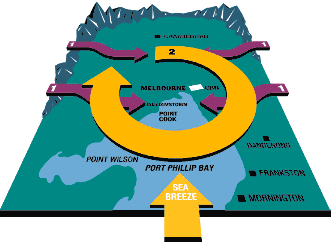The term smog was first coined during the 1950s when it was used to describe a mixture of smoke and fog experienced in London. Major cities along the west coast of America were also experiencing a different type of air pollution.
Smog occurs when emissions from industry, motor vehicles, incinerators, open burning and other sources accumulate under certain climatic conditions. There are two types of smog: summer (the type of smog first experienced in America) and winter (the one first noticed in London).
Autumn and winter smog (particles)
During the cooler months (April to September), Melbourne is more affected by the accumulation of fine particles, which come from motor vehicle emissions, wood smoke, other combustion processes and photochemical processes in the air.
Temperature inversions in winter mean that warm air higher in the atmosphere traps pollutants in the layer of cold air closer to the ground. These inversions can last for several days and cause ‘scummy’ brown hazed horizons until dispersed by wind or rain.
The fine particles scatter sunlight, reduce visibility, soil buildings and fabrics and provoke existing respiratory diseases and other health problems.
Photochemical or summer smog
In the warmer months (October to March), photochemical smog (summer smog) is caused by the action of sunlight on a mixture of hydrocarbons and oxides of nitrogen. This smog contains secondary pollutants such as ozone, aldehydes and fine particles.
Sometimes winds cause the pollutants to be carried clockwise around the Port Phillip region. As the smog levels build, polluted air can be trapped and recirculate for days in what is known as the Melbourne Eddy.
This means that in the evening you can end up breathing exhaust fumes emitted by your car that morning.
A typical Melbourne Eddy

The Spillane or Melbourne Eddy at work. Under a special set of meteorological conditions, air flowing from the north east is funnelled by mountains to the north and east of Port Phillip Bay (1), creating a circular, horizontal motion about 100 kilometres in diameter (2). The eddy pushes air pollution out over the Bay, taking it away from Melbourne.
You might recognise photochemical smog as the whitish haze that sometimes settles over our cities during summer. The best way to determine the amount of summer smog is to measure ozone levels in the air.
Ozone levels
Photochemical (summer smog) forms when pollutants such as nitrogen oxides and organic compounds react together in the presence of sunlight. A gas called ozone is formed.
Nitrogen dioxide + sunlight + hydrocarbons = ozone
This is a very general representation of the formation of ozone in the lower atmosphere. In actual fact, many different chemical reactions produce ozone.
But I thought ozone was good?
Ozone plays different roles at different levels in the atmosphere.
In the upper atmosphere it shields away the harmful effects of the sun’s ultraviolet rays.
In the lower atmosphere it harms human health, vegetation and materials.
Ozone has an impact on everybody in the population, especially the young, elderly and people with respiratory or cardiovascular problems. For example, increases in ozone levels can trigger asthma attacks and increase our susceptibility to infection.